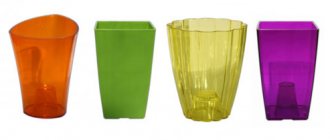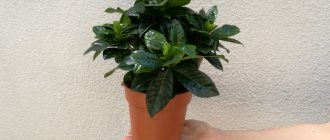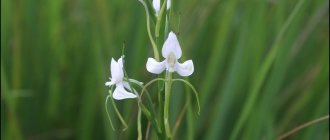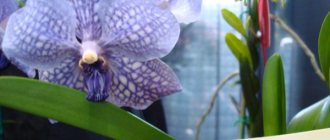Growing principles
There is an opinion that domestic cyclamen species are very difficult to care for. But that's not true. The flower is quite unpretentious. It will not cause much trouble when growing if you follow simple rules:
- Cyclamen does not tolerate high temperatures. The optimal temperature for it during the flowering period is 8-12 C.
- Direct sunlight will cause leaves to yellow and fall off.
- The tuber should not be completely buried in the ground. One third should remain on the surface.
- The pot for planting should be small. The distance from the tuber to the walls of the pot should be 2-3 cm.
- Does not like excess salts in the soil with intensive use of fertilizers.
The peculiarity of cyclamen is that it blooms constantly from autumn to April-May. For three summer months, the flower enters a dormant period when the flowers fall off.
We talked in detail about how to care for cyclamen during and after flowering here.
Types of homemade cyclamen with photos and names
There are two types of domestic cyclamen: Persian and European. They vary in care and life cycle.
Cyclamen persica
Its second name is alpine violet. It has a large flattened tuber. The leaves are gray-green to dark green with a bluish pattern. Varieties have different flower colors: white, red, pink and all shades of purple. The size of the flowers depends on the variety. Small-flowered varieties have a delicate aroma and are better adapted to apartment conditions.
Popular varieties:
- Cardinal . It has bright large scarlet flowers. The growth of the bush reaches 30 cm.
- Kaori . A dwarf variety with small flowers with a pleasant scent. The stigma of the bud has a contrasting color.
- Rex . Average size of flowers and bush. The leaves are decorated with a silver pattern.
- Decor . Beautiful color of buds. There are salmon, purple and pink flowers. Leaves with marble patterns.
European cyclamen
A distinctive feature of this species is its life cycle. It has no dormant period and has leaves all year round. It has smaller flowers and leaves than the Persian variety.
The most common colors of flowers are shades of pink and purple. Most suitable for growing at home. Feels comfortable at temperatures up to 20⁰C and low humidity.
Photo
Look what cyclamen looks like in the photo, which is properly cared for:
Caring for cyclamen at home
Illumination
In order for cyclamen to grow and develop fully, it needs proper lighting. A western or eastern window sill is best suited for this flower. Since direct rays of the sun can harm the plant, if you have to place it on a south-facing window sill, choose a place away from the window or shade it. The north window is not suitable for a flower, as there is very poor lighting there.
Temperature
In winter, normal development and lush flowering of cyclamen is possible only if the air temperature is between 10–14 degrees. In the warm season, the optimal temperature for such a plant is 20–25 degrees.
Watering
Water the flower with soft water, the temperature of which is 2 degrees below room temperature. It is collected in a container 24 hours before watering and allowed to settle well. Throughout the flowering period, watering should be plentiful. Do not allow the substrate in the pot to dry out, and also ensure that liquid does not stagnate in it. Bottom watering (through a tray) is well suited for cyclamen; in this case, water will not fall on the tuber, core and buds of the bush. When the plant is watered, after 2-3 hours, be sure to pour out excess water from the tray. At the end of flowering, watering is reduced, and when all the foliage has completely dried out and the tuber is exposed, watering should become very meager and infrequent.
Air humidity
In order to increase air humidity, the bush is moistened with a spray bottle, using rain or well-settled water. However, such a procedure can only be carried out until buds form, and after that, another method is used to increase the humidity level: wet peat or pebbles are poured into a tray and a flower pot is placed on it. Make sure that the bottom of the container does not come into contact with water.
Top dressing
Features of feeding cyclamens:
- frequency of fertilization - once every 2-4 weeks;
- It is recommended to use fertilizers with moderate nitrogen content;
- if the leaves turn yellow, you need to apply iron-containing fertilizer - by watering or spraying;
- Feeding is stopped in April - the plant begins to prepare for the dormant period.
Excess nitrogen leads to leaf growth and negatively affects the quantity and quality of buds.
Bloom
Cyclamen grown at home is capable of blooming magnificently for up to fifteen years in a row, and up to 70 spectacular flowers will form on it annually. After the flowers wither, they, along with the peduncle, are carefully pinched off near the tuber; cutting them off is extremely undesirable. Then the rupture site is treated with powdered charcoal.
Rest period
As soon as the foliage of a flower begins to dry out and die, this indicates that a dormant period has begun. Reduce the frequency and abundance of watering, and this should be done gradually. And when the plant is completely bare, water it sparingly and infrequently.
The room where the plant is located is systematically ventilated. If possible, move it to a balcony that is protected from the sun. In August or September, the bush is moved to a well-lit place and watering begins to gradually increase. During the dormant period, the flower can be stored at home in another way: when the bush has faded, reduce watering, and when all the foliage has died off, the pot should be turned 90 degrees and in this position it will be stored until the last summer or first autumn weeks .
Replanting cyclamen
Transplantation is carried out annually in August or September, and this is done after the first foliage appears from the tuber. The container for transplantation is chosen to be wide and filled with loose substrate with a pH of 5.5–6. The approximate composition of the soil mixture is: humus, sand and peat (one part each), and also leaf soil (2 or 3 parts). You can also use a substrate of the following composition: sand, humus and leaf soil (1: 2: 4). If the pH of the soil mixture is above 6.5, then the likelihood that the plant will be affected by fungal diseases increases.
After the bush is removed from the pot, cut off all rotten roots, while trying not to injure healthy ones. When planting a tuber, keep in mind that it should rise by half or a third above the soil mixture, thanks to this the flowering of the cyclamen will be more magnificent. To avoid stagnation of water in the root system, do not forget to make a good drainage layer at the bottom of the container.
Virulence
The juice of any part of the Persian cyclamen bush, as well as its tuber, contains toxic substances that can cause diarrhea, cramps and vomiting.
What are the benefits of cyclamen?
An infusion is prepared from cyclamen, which is used for colic, rheumatism, neuralgia, digestive disorders and flatulence.
Is it often required during flowering and dormant periods?
There are no clear instructions on how often you should water cyclamen at home. The main indicator of the need for watering is the dryness of the top layer of soil. Just test the soil in the pot with your finger. If the finger immersed 2 phalanges into the ground remains dry, then it is time to water.
Another sign that watering is needed is when the leaves lose their elasticity. During the flowering period, 2 waterings per week will be sufficient. In summer - once every two weeks.
Common mistakes
Even small mistakes in watering can cause the death of cyclamen. Therefore, you need to comply with all the requirements of the plant, and then it will delight you with lush flowering.
Possible mistakes.
- No watering during the dormant period. You need to moisten the substrate in the pot regularly, even if the plant is resting. Ignoring this rule can lead to drying out of the tuber.
- Cold water for irrigation. In this case, the roots of the plant cannot fully perform their function, which leads to disruption of metabolic processes in tissues.
- Watering from above. When water gets on the top of the tuber, it rots. Therefore, cyclamen can be watered from above only along the edge of the pot.
- Excessive watering after rest. The volume of water must be increased gradually so that cyclamen can adapt to the new rhythm.
How to fertilize and feed?
During the flowering period, after summer hibernation, the plant needs to grow leaves, buds and flowers in a short period. The flower actively draws essential minerals from the soil. If the soil is depleted, then further growth and flowering are impossible, which means feeding is needed. Purchase special fertilizers for violets and other indoor plants at the flower shop. These can be mineral complexes with ammonium and potassium nitrate, superphosphates.
When choosing nitrogen, potassium and complex fertilizers, priority should be given to potassium ones. Experienced flower growers recommend taking the following preparations:
- Ideal.
- Blooms.
- Kemira Suite.
- Ferovit.
- Peace.
Opponents of chemical fertilizers prefer to use biological fertilizers. As a top dressing they add to the soil:
- yeast solution;
- wood ash;
- dried banana peel as a source of potassium;
- bird droppings;
- tincture of cattle manure;
- tincture from food waste.
On a note. To prevent diseases and provide mineral nutrition, the soil can be treated with an infusion of onion peels, garlic and other medicinal herbs.
Pests and diseases
Wet rot
Bacteria, entering the flower tissue, destroy the plant: peduncles and leaves become sluggish, and an unpleasant odor appears. The roots also die. It is necessary to get rid of the diseased plant.
Gray rot
In damp and cold air, fungi begin to multiply. A gray coating appears on flowers and leaves. Then the affected leaves turn yellow, the stems darken and disappear. Diseased parts need to be removed and the plant treated with fungicides. Read more here.
Fusarium wilt
Externally, the disease begins with yellowing of the tops of the leaves, although initially the fungi enter the soil and infect the roots and lower parts of the stem. In the fight against the disease, foundationazole is used. The soil under the root is watered with a 0.1% solution of the drug. Read more about methods of combating fusarium here.
Cyclamen mite
The most common pest of cyclamen. Unlike mites that attack other flower crops, this pest is very small, 0.1–0.3 mm in size. Habitat: lower part of leaves. When there is a massive accumulation, it seems that the plant is covered with dust. Leaves begin to curl, buds and flowers fade and growth slows down. Affected leaves are removed.
Aphid
It also disfigures plants. By sucking juices from leaves and stems, insects leave sticky transparent secretions. If aphid colonies are few in number, the plants are washed with soapy water. Insecticides help with severe damage.
Types of watering indoor plants
Cyclamen grows at home in pots. There are 3 main ways to water cyclamen growing in pots without causing harm to the leaves, tubers and flowers.
Using a watering can
Carefully place the spout of a small watering can or funnel against the inner wall of the pot and slowly move it around the circumference to moisten the soil. After an hour, excess water that has drained into the pan should be drained.
You should never water the aboveground part of the plant, leaves, stems, flowers, tubers. With such watering, the flower becomes sick with gray rot and other fungal diseases and dies.
Immersing the pot in liquid
- Fill the basin with water from the tap.
- Let sit for at least a day.
- Immerse the flower in water so that the edge of the pot protrudes 1 cm above the water.
- Leave until a characteristic wet sheen appears on the soil surface.
This means that the earth has absorbed the required amount of water. Then you can remove the pot and let the excess water drain.
Important! Do not put several pots in one basin and do not use the remaining water to water other plants. Diseases can be transmitted from one flower to another through the liquid.
Humidification from the tray
Some gardeners place the flower in a tray with low sides. A little water is poured into the pan. From the bottom of the tray, through the hole in the pot, pull a thread reaching the surface of the soil. Using osmosis, water is drawn from the pan along a thread and distributed evenly in the soil.
To prevent water from evaporating, the bottom of the tray is lined with moss, pebbles, and pieces of wood, which also serve as decorative elements.
Watch a video about watering cyclamen using a tray:
Watering cyclamen in winter
Cyclamen is a winter flower; during this period it actively develops and blooms. Therefore, it is important to provide it with adequate watering as needed. But at the same time you need to monitor the air temperature. The higher it is, the faster moisture evaporates from the substrate. Therefore, watering must be carried out taking into account the characteristics of the flower. You cannot sharply increase watering when the first buds appear, as this can provoke the development of tuber rot. This must be done gradually so that the plant can get used to it.
In addition, in winter, heating systems operate actively, which significantly reduces air humidity. To correct this, it is necessary to place additional containers of water near the pot with cyclamen, which will increase the area of evaporation.
Learning to replant correctly
In order to correctly transplant cyclamen, use the following algorithm:
- Carefully shake out the contents of the pot.
- We remove rotten roots.
- We cut out the rotten part of the tuber to a healthy place.
- Dry the cut area using crushed activated carbon.
- Treat with Topaz or other fungicide.
- Plant in fresh sterilized soil for cyclamen.
Caring for cyclamen at home
Illumination
In order for cyclamen to grow and develop fully, it needs proper lighting. A western or eastern window sill is best suited for this flower. Since direct rays of the sun can harm the plant, if you have to place it on a south-facing window sill, choose a place away from the window or shade it. The north window is not suitable for a flower, as there is very poor lighting there.
Temperature
In winter, normal development and lush flowering of cyclamen is possible only if the air temperature is between 10–14 degrees. In the warm season, the optimal temperature for such a plant is 20–25 degrees.
Watering
Water the flower with soft water, the temperature of which is 2 degrees below room temperature. It is collected in a container 24 hours before watering and allowed to settle well. Throughout the flowering period, watering should be plentiful. Do not allow the substrate in the pot to dry out, and also ensure that liquid does not stagnate in it. Bottom watering (through a tray) is well suited for cyclamen; in this case, water will not fall on the tuber, core and buds of the bush. When the plant is watered, after 2-3 hours, be sure to pour out excess water from the tray. At the end of flowering, watering is reduced, and when all the foliage has completely dried out and the tuber is exposed, watering should become very meager and infrequent.
Air humidity
In order to increase air humidity, the bush is moistened with a spray bottle, using rain or well-settled water. However, such a procedure can only be carried out until buds form, and after that, another method is used to increase the humidity level: wet peat or pebbles are poured into a tray and a flower pot is placed on it. Make sure that the bottom of the container does not come into contact with water.
Fertilizer
You need to start feeding the flower from the moment its leaves appear; for this, use a complete mineral or organic fertilizer. As soon as flowering begins, all feeding is stopped. Remember that if there is too much nitrogen in the substrate, then this can lead to rot on the tuber.
Rest period
As soon as the foliage of a flower begins to dry out and die, this indicates that a dormant period has begun. Reduce the frequency and abundance of watering, and this should be done gradually. And when the plant is completely bare, water it sparingly and infrequently.
The room where the plant is located is systematically ventilated. If possible, move it to a balcony that is protected from the sun. In August or September, the bush is moved to a well-lit place and watering begins to gradually increase. During the dormant period, the flower can be stored at home in another way: when the bush has faded, reduce watering, and when all the foliage has died off, the pot should be turned 90 degrees and in this position it will be stored until the last summer or first autumn weeks .
Bloom
Cyclamen grown at home is capable of blooming magnificently for up to fifteen years in a row, and up to 70 spectacular flowers will form on it annually. After the flowers wither, they, along with the peduncle, are carefully pinched off near the tuber; cutting them off is extremely undesirable. Then the rupture site is treated with powdered charcoal.
Replanting cyclamen
Transplantation is carried out annually in August or September, and this is done after the first foliage appears from the tuber. The container for transplantation is chosen to be wide and filled with loose substrate with a pH of 5.5–6. The approximate composition of the soil mixture is: humus, sand and peat (one part each), and also leaf soil (2 or 3 parts). You can also use a substrate of the following composition: sand, humus and leaf soil (1: 2: 4). If the pH of the soil mixture is above 6.5, then the likelihood that the plant will be affected by fungal diseases increases.
After the bush is removed from the pot, cut off all rotten roots, while trying not to injure healthy ones. When planting a tuber, keep in mind that it should rise by half or a third above the soil mixture, thanks to this the flowering of the cyclamen will be more magnificent. To avoid stagnation of water in the root system, do not forget to make a good drainage layer at the bottom of the container.
How to properly transplant cyclamen at home
Watch this video on YouTube
Virulence
The juice of any part of the Persian cyclamen bush, as well as its tuber, contains toxic substances that can cause diarrhea, cramps and vomiting.
What are the benefits of cyclamen?
An infusion is prepared from cyclamen, which is used for colic, rheumatism, neuralgia, digestive disorders and flatulence.
Alpine violet diseases
- If leaves and flowers begin to fade in winter, it means that the cyclamen is dying from too much moisture or water getting on the tuber. A flower can be saved by replanting. If the affected area was small, then the flower survives and is restored.
- If the tuber is covered with cracks. Most likely from excess moisture. Reduce the number of waterings and add 2 drops of Fitosporin to the water.
- With insufficient watering or dry warm indoor air, cyclamen may have diseased leaves, but the flowers remain large and strong. You should increase the number of waterings, humidify the air with a spray bottle, or move it to a more humid place.
You will find more information about cyclamen diseases and ways to combat them here.
Watering, fertilizing and caring for cyclamen at home does not require daily effort and special material costs. The plant is quite unpretentious and, with proper care, will delight you with beautiful flowers in the cold season, reminding you of the warm summers.
How to understand that it’s time to water cyclamen
Cyclamen needs high air humidity, but does not tolerate excess moisture in the soil. Constant overwatering can lead to the death of the plant as a result of rotting of the tuber. Therefore, you should water the flower only as needed.
There is one reliable way that will help you understand whether cyclamen needs water or not. To do this, simply stick your finger into the soil. If the soil in the middle is moist, there is no need to water. And if the soil is completely dry, then it’s time.
Sometimes you can tell what needs to be watered by the appearance of the plant. In this case, the leaves and flowers become limp and begin to fade without prior yellowing. This occurs due to a slowdown in metabolic processes in tissues. Therefore, you should urgently water the plant, otherwise a dormant period will begin.
When the substrate dries out, the leaves and peduncles of cyclamen lose turgor
Basic watering methods
The plant is watered in two ways: top and bottom.
The top method is watering from a watering can, which is familiar to many.
- Advantages of the method:
- ease of implementation;
- no need to move the flowerpot;
- control of soil impregnation level.
- Among the disadvantages of the top method:
- You need to water in 2-3 approaches so that the soil is saturated evenly;
- with uncontrolled moisture, you can flood the soil too much;
- water can get on the flower itself;
- an hour after moistening, you need to empty the tray;
- water partially washes away mineral salts;
Did you know? Other names for cyclamen are alpine violet and dryer.
The bottom method is that cyclamens are often moistened through drainage holes. To do this, the pot with the plant is placed in a container with water. When the soil is completely saturated, the liquid is allowed to drain.
- The advantages of the method are as follows:
- the plant itself determines the amount of water it needs;
- even very dry soil is saturated;
- the substrate is immediately moistened evenly;
- the flower itself is not affected.
- However, the method also has disadvantages:
- labor-intensive process;
- the flower pot needs to be moved;
- through drainage, water cannot always reach the top layer of soil;
- Excess salts accumulate in the substrate.











